The Great Gloom: In 2023, Employees Are Unhappier Than Ever. Why?
First came the Great Resignation—and now businesses around the world are experiencing the Great Gloom.
From the start of 2020 through the present, employee happiness has steadily declined at a rate of 6%. But 2023 has seen a steep and steady drop, with a decrease of 9% in eNPS since January, declining at a rate 10x faster than the previous three years.
As employees become unhappier, volatility—or how happiness varies from month to month—is steadily decreasing as well. Today, employees experience less extreme highs and lows than ever before. Most simply accept that morale is getting worse.
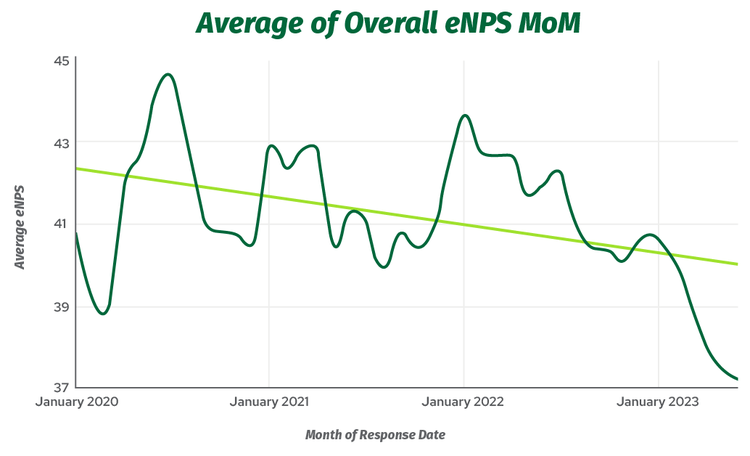
The data comes from BambooHR's database of employee Net Promoter Scores® (eNPS)*, collected monthly from January 2020 through June 2023—now released publicly for the first time.
BambooHR's findings echo other recent studies. According to Gallup's July 2023 survey, 80% of Americans are dissatisfied with the way things are going in the US. Job satisfaction has dropped by 8% since 2019.
To learn more about how these trends are impacting the workplace, we analyzed eNPS data from more than 1,600 companies, including more than 1.4 billion self-reported eNPS scores since January 2020. We considered:
- Employer Net Promoter Score (eNPS): eNPS helps employers measure employee satisfaction. It consists of two questions—a numeric rating of how likely employees are to recommend the organization as a place to work, and an open-ended question about their reasoning. These scores (categorized as promoters, passives, and detractors) are used to quantify how employees feel about their company.
- Volatility: Volatility is the total movement of eNPS over time, calculated using the percentage difference between each month's average eNPS. High volatility reflects more dramatic highs and lows within a time period, while low volatility denotes consistency.
- Average Volatility: A sum of the difference between each month’s average eNPS, showcasing volatility as eNPS movement rather than a percentage.
Read on to discover which industries are most severely affected—and what human resources professionals, managers, and business leaders can do to remedy the situation.
*Net Promoter, NPS, and the NPS-related emoticons are registered U.S. trademarks, and NetPromoter Score and Net Promoter System are service marks, of Bain & Company, Inc., NICE Systems, Inc. and Fred Reichheld.
Key Takeaways for Human Resources Professionals
- Use data-driven approaches to measure employee happiness. Anonymous surveys through HR platforms—such as BambooHR® Employee Satisfaction—help you gain insights into how employees really feel. Casual or observational methods won’t give you the full truth, as employees may conceal their unhappiness for fear of backlash. At worst, C-suite leaders may have little idea that morale is at risk until it begins to show up in costly turnover or lost productivity.
- Focus on the norms in your industry. Macroeconomic challenges impact some industries more than others. You can use BambooHR's Employee Happiness Index to keep tabs on your industry's benchmarks.
Key Takeaways by Industry
- The construction industry is the happiest on our list, potentially because of rising wages and plentiful job opportunities. However, experts predict labor shortfalls that may put pressure on employees in the months ahead. Human resources professionals should focus on refining their recruitment strategies and training programs to prepare for an influx of less experienced workers.
- In the technology sector, employee happiness is plummeting fast. Beyond industry-wide financial stumbles, unpopular return-to-office mandates may be to blame. Human resources professionals should reconsider and advocate for flexible or fully remote work environments.
- The finance industry has managed to remain nimble and responsive to fast-changing workplace norms. Its openness to remote and hybrid work, as well as its focus on company culture, promise to sustain employees' high levels of satisfaction.
- Since 2008, nonprofit employment has grown 3x faster than the for-profit sector—possibly due to nonprofits' mission-driven cultures. As more workers crave meaning, nonprofits should continue focusing on benefits and professional development opportunities.
- In the restaurant and food and beverage industries, staff shortages are putting pressure on employers to raise wages. However, money isn't the only factor that influences happiness. Employees want to work in a positive, supportive environment that offers professional development opportunities.
- As the travel and hospitality industry recovers from the pandemic, employee happiness is steadily improving. But looming staff shortages threaten this industry's stability—so HR professionals should focus on recruitment and retention, including compensation, benefits, and professional development opportunities.
- Educators feel overworked, underpaid, and underappreciated. Human resources professionals should advocate for changes that educators value most, including adequate compensation, a supportive workplace culture, and assistance navigating the tense political environment.
- Healthcare is the unhappiest industry on our list. Human resources professionals should strive to foster a culture where employees feel valued and included in effectively run teams. Healthcare workers are more likely to commit to a values-driven employer who prioritizes high-quality, patient-centered care.
Employee Happiness Index Benchmarks (2020–Present)
Overall, June 2023 represents an all-time low for employee happiness, which peaked near the beginning of the pandemic in April 2020.
In April 2020, happiness spiked to an all-time high (45 eNPS) as the initial shock of lockdowns faded and more information about the virus—and relief plans—emerged. Nearly two-thirds of employees (63%) identified as promoters, likely out of sheer gratitude as the US unemployment rate soared to a record-breaking 14.7%.
Beyond the workplace, the 2020 pandemic ushered in historic levels of overall unhappiness. As the public health crisis upended normal life, Americans struggled with lockdown-induced isolation, depression, and irritability. Just 42% believed their children's future standard of living would be better than their own, the most pessimistic outlook since data collection began in 1994.
After 2020, Americans began to rediscover a sense of normalcy. Both 2021 and 2022 began with high levels of happiness and provide a benchmark for how employee satisfaction fluctuates throughout a typical year. Positive sentiments gradually tapered off throughout the summer months before rebounding slightly as the winter holidays approached.
But so far, 2023 mirrors the dramatic, atypical patterns we saw during the first months of the pandemic. Employee happiness is plunging dramatically, with no signs of recovery.
April 2023 saw the highest level of employees identifying as detractors (18%), while the average percentage of promoters trended downward slightly. Employee satisfaction reached another low point of the last few years in June 2023, with an eNPS of 37.
This reflects the way the pandemic's lingering health and economic effects continue to disrupt Americans' lives. Around 65 million people now live with long COVID, with symptoms spanning cognitive problems, respiratory issues, and chronic fatigue. In June 2023, real wages rose faster than inflation for the first time in more than two years—yet 61% of Americans still live paycheck to paycheck and 21% struggle to pay their bills.
In 2023, Employees Are Resigned to Their Unhappiness
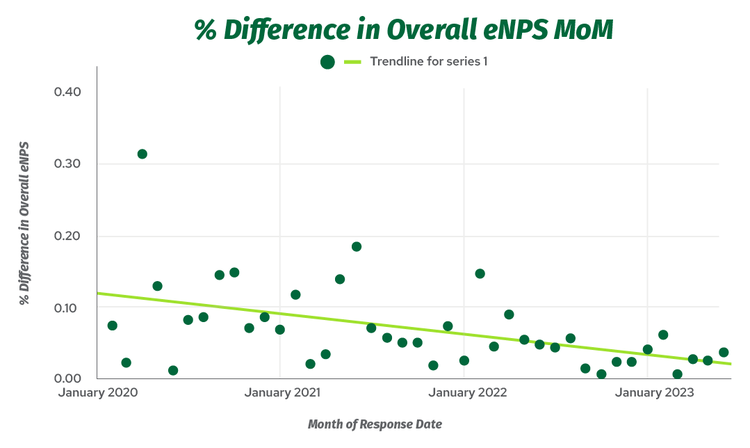
Like employee happiness, volatility has decreased throughout 2023. Employees report more consistent eNPS results, with less month-to-month variability than previous years.
In 2020, volatility was at an all-time high, with the difference month to month adding up to 118 percentage points of movement across the entire year. That's nearly 6x the level of volatility we're seeing in 2023, when employees' self-reported happiness has varied just 20 percentage points since January.
When it comes to average eNPS volatility, 2023 has seen just 3 points of movement from January through June—compared to 11 points of movement throughout 2020.
Employees aren't experiencing highs or lows—instead, they are expressing a sense of resignation or even apathy.
What Is the Happiest Sector of the Workforce?
8 Major Industries, Ranked
We used employees' self-reported eNPS data in BambooHR Employee Satisfaction to identify the happiest—and unhappiest—industries in 2023, based on average eNPS.
Of the industries we analyzed, construction is the happiest industry. It’s also one of the least volatile. Construction workers tend to agree from month to month, with little range in their average eNPS.
By contrast, the healthcare industry is the least happy. Healthcare employees reported negative trends since 2020—outmatched only by restaurants and the food and beverage industry. Like construction, healthcare has little volatility, meaning healthcare workers largely agree on their unhappiness from month to month.
1. Happiest Industry: Construction
Overall, the construction industry stands out as the happiest industry in the first two quarters of 2023.
While employee happiness has fluctuated over the past three years, construction workers' eNPS have remained consistently high. The average eNPS ranges from a low of 48 in 2022 up to a high of 53 in 2021.
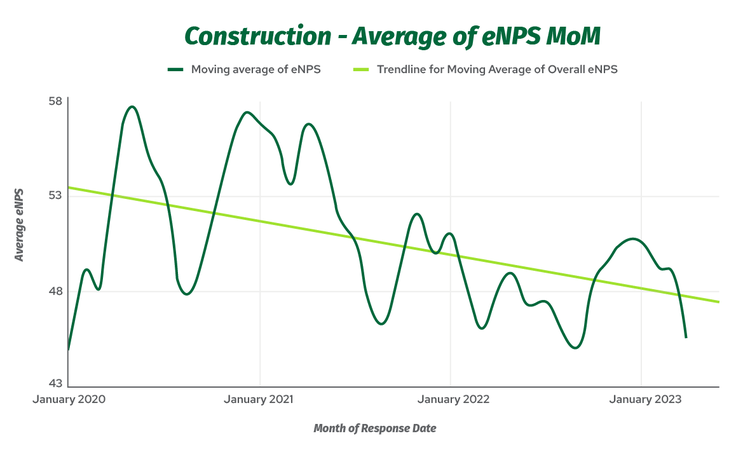
Happiness peaked in 2020, despite turbulent times that rattled the construction industry. Residential construction projects boomed, and construction material shortages created deep backlogs of work that brought much-needed stability. Most importantly, the CARES Act and the American Rescue Plan pumped more than $4 trillion into the economy, boosting contractors' optimism.
Since then, construction workers' happiness has tapered slightly and currently holds steady at an average eNPS of 49. The industry typically experiences seasonal patterns of happiness, with lower scores around the fall and rising happiness as the year ends.

Volatility has decreased year over year, from an all-time high of 203 percentage points of movement in 2020. So far, we've seen just 37 percentage points of movement in 2023.
Human resources professionals in the construction industry should be alert to signs of discontent. From January through May 2023, happiness declined at a steep rate of 81% —a sharper drop than the gentle decreasing rate of 13% negative trendline from 2020 through the present.
Relevant industry trends include:
High demand for construction work: As global supply chains collapsed during 2020, the manufacturing industry's spending on construction consistently increased, reaching nearly $2 million in monthly spending in 2023, according to the US Census Bureau. In August 2021, President Joe Biden signed a bipartisan infrastructure plan that will inject $550 billion into roads, bridges, and high-speed internet infrastructure, among other construction projects.
Rising wages: Hourly construction wages soared to a 40-year high in 2022. According to Payscale, today's median hourly wage for a construction worker is $17.58—but wages can be as high as $28.58.
Looming staff shortages: The Associated Builders and Contractors predicts a shortfall of 546,000 workers needed to meet demand. Left unchecked, this will put more pressure than ever on workers within the industry and could lead to an influx of inexperienced workers with greater needs for training.
2. Plummeting Happiness: Technology
The technology sector is currently the second-happiest industry—but this achievement is very unlikely to last.
Blame 2022's strong finish for skewing the tech industry’s average happiness. In 2023, tech is seeing the sharpest decline on our list, with a plummeting 145% rate of decline.
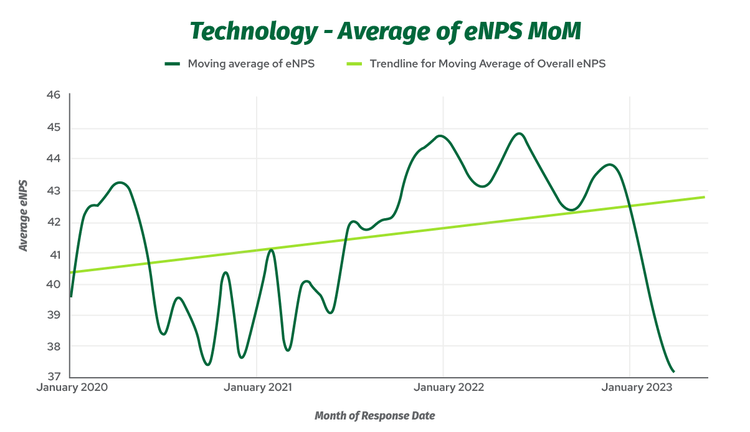
This drop is especially striking given the high levels of happiness in late 2021 and throughout 2022, when the tech industry achieved its highest overall average eNPS since the start of 2020.
What caused the sudden plunge? In early 2023, the venture capital that powered tech startups began to dry up in the face of rising inflation, and a run on the Silicon Valley Bank by startups precipitated the second-largest bank failure in US history.
Layoffs quickly followed. As of August 2023, more than 225,000 tech workers from 932 companies have lost their jobs, dealing a serious blow to remaining employees’ morale.
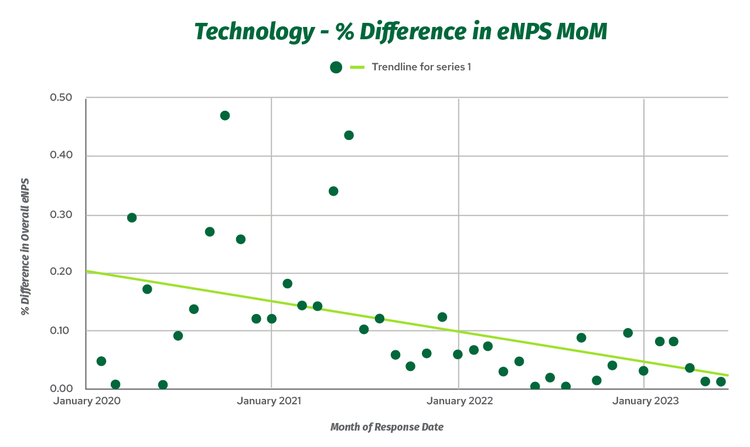
As historic events rock the tech sector, employee happiness has the least volatility and most alignment of any industry on our list. In 2020, volatility was at an all-time high with 187 percentage points of movement across the entire year, compared to only 25 percentage points of movement in 2023.
Tech companies can't reverse these upheavals overnight—but human resources professionals can help craft company policies aimed at boosting employee happiness:
Return to office missteps: Many tech employers are going back on their remote-work promises. According to research by Pew Research Center, 33% have now decided against hybrid models, and 35% now want employees in the office all the time. But forcing employees to return to the office will likely push many past their breaking point—66% of employees say they would quit their jobs if they were required to return to the office full-time. If tech companies want to improve employee happiness, reconsidering those return-to-office plans may be their best opportunity for immediate impact.
Happier remote workers: As of 2022, the tech industry was a clear leader in offering remote work options, according to an analysis of 6 million job advertisements on Glassdoor, and a recent survey of more than 12,000 employees found that remote work boosts employee happiness by up to 20%.
3. Steadily Declining Happiness: Finance
Finance workers' happiness has steadily declined over the past three years.
In 2023, the finance industry's average eNPS is 37—nearly 7 points lower than its average score of 44 from 2020 through 2022.


Yearly volatility has decreased dramatically, with more consistent monthly eNPS. Volatility peaked in 2020 with 373 percentage points of movement across the year, and the average eNPS had 38 points of movement.
In 2023, those dramatic highs and lows have dwindled to just 100 points of movement. The average eNPS has seen 23 points of movement.
HR pros in the finance industry have a solid foundation to build on, but there’s room for companies to raise happiness levels:
Improve flexible offerings: Despite ranking fourth in most flexible industries, financial companies lag behind other top-ranking industries (e.g., tech and media). Giving employees options around hybrid and remote work may help the finance sector improve.
Maintain a positive baseline: Compared to workers in other industries, finance workers are more engaged, and they’re generally positive about decision-making, wellbeing, and leadership at their organizations. According to Deloitte, the finance industry has been adaptive and nimble throughout the pandemic. Its openness to remote and hybrid work, as well as its focus on company culture, has shored up employee happiness during a time when many other industries are struggling.
4. Increasing Happiness: Nonprofit
Unlike most industries, nonprofits are trending toward greater employee happiness in 2023, with a 71% rate of increase from January through June.
Employee happiness is likely to improve further as seasonal times of giving approach. For example, on November 29, 2022—known as "Giving Tuesday"—nonprofits and charities received $3.1 billion in donations, a 25% increase from 2020. Additionally, nearly one-third of giving (31%) occurs in December as the fiscal year comes to an end.
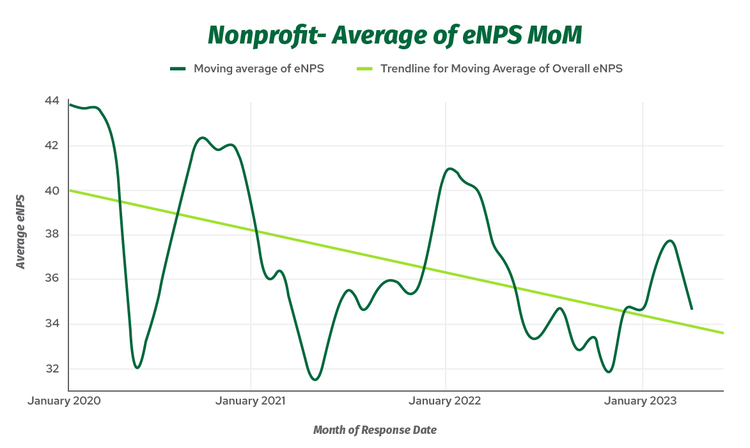

HR pros should keep their focus on mission and purpose while looking for ways to improve the employee experience:
Purposeful cultures: A 2023 Gartner report found that employees increasingly crave purpose at work. This desire for meaning helps to explain why nonprofit employment has grown more than 3x faster than the for-profit sector (33% vs. 9%) since 2008. Nonprofits' mission-driven cultures help explain why workers remain so happy, despite earning $3.36 per hour less than their for-profit counterparts.
Focusing on employee retention: However, in a 2022 survey, nonprofit workers identified morale and employee retention as their biggest challenges after budgetary concerns. To shore up employees' long-term happiness, nearly half of nonprofits plan to improve their benefits (47%) or improve professional development opportunities (46%).
5. Slowing Unhappiness: Restaurants, Food and Beverage
Despite COVID-19's disruptions to in-person dining, employees in the food and beverage industry reported the highest levels of happiness (48) in 2020. Since then, the average eNPS has gradually declined, arriving at its lowest point (35) in 2023.
While this may seem discouraging, the trend toward unhappiness is softening. From January 2020 through June 2023, we saw a trendline decreasing at a rate of 39%—but that's mellowed to a decline of 24% in 2023 alone.
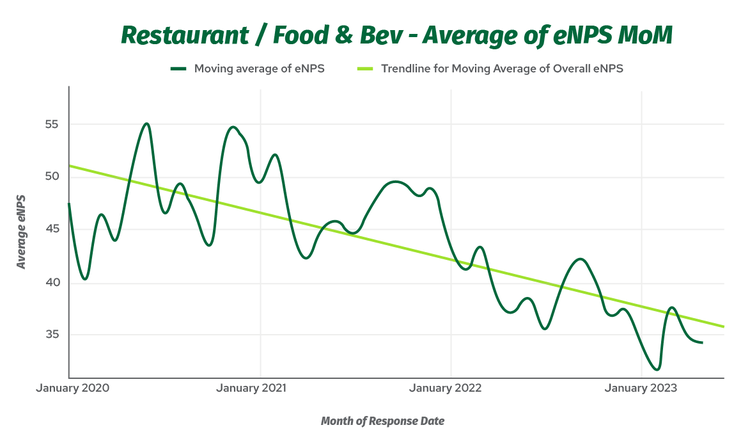
HR managers face complex challenges in 2023, particularly around employee experience:
Labor unions: Restaurant employees want better wages and working conditions—and unionizing is on the rise. As of August 2023, more than 8,500 Starbucks employees in 337 locations nationwide have voted to join Workers United.
Open jobs and rising wages: Activism, coupled with a labor shortage that’s left thousands of jobs unfilled, is putting pressure on the industry. In a recent survey of 3,000 restaurant operators, the National Restaurant Association found that 79% are struggling to hire. Although the federal minimum wage hasn't increased since 2009, 28 states and Washington, DC, voluntarily increased their minimum wage within the past year.
Growth opportunities: Restaurant workers say that money isn't the only thing that matters. Just 39% of restaurants invest in professional development opportunities, down from 43% in the pre-pandemic era. The same report found that 72% of employees agree that internal communication greatly impacts their happiness at work. That means businesses that center employee wellbeing and support can stand out from the crowd.
6. Rising Happiness: Travel and Hospitality
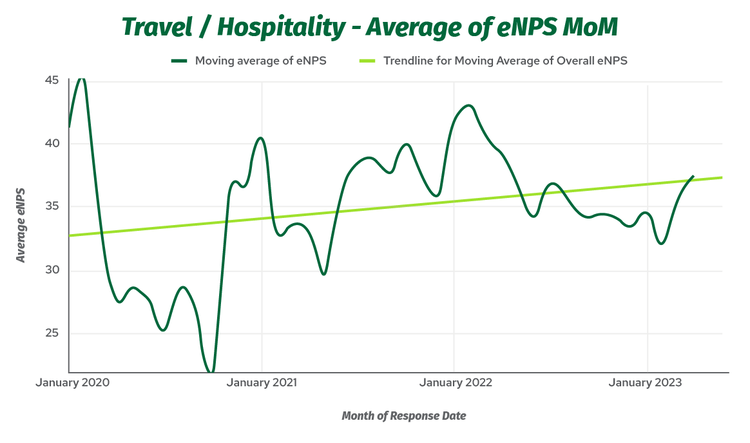
As lockdowns eased, restless Americans displayed a surging interest in "revenge travel" to make up for opportunities they'd missed during the height of the pandemic. Although airfare has remained pricey, AAA booking data shows that international travel has increased by 200% compared to 2022.
Employee happiness hasn't recovered from its peak in January 2020, but it's on the rise with an overall positive trendline, increasing by a rate of 8%. When we examined 2023 alone, we found that happiness is on a more sharply positive 59% rate of incline.
As the industry recovers, yearly volatility has decreased dramatically. Volatility peaked in 2020, with an astounding 1,228 percentage points of movement throughout the year—and the industry's average eNPS swung wildly, with 51 points of movement.
In 2023, volatility has dropped to just 185 percentage points of movement. The average eNPS has only fluctuated 8 points, showcasing employees' recovering sense of stability.
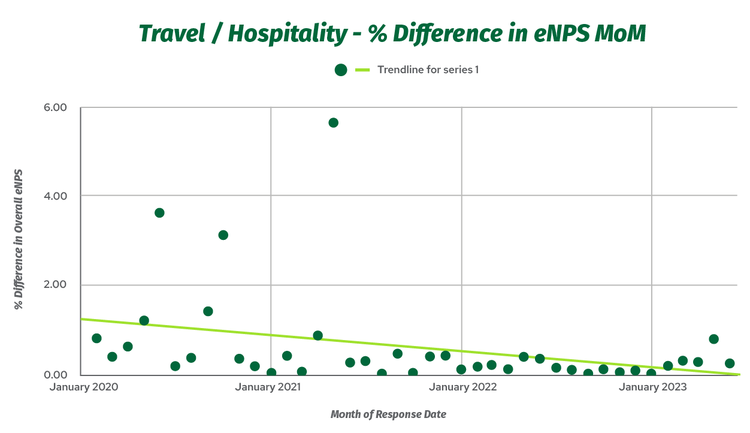
More travel hasn’t automatically resulted in more workers. HR's biggest challenge will be managing labor shortages:
Dramatic shortages in hospitality: A recent American Hotel & Lodging Association survey found that 87% of hotels were still experiencing staff shortages, including 36% who considered the shortages "severe." Compared to other hotel workers, housekeeping teams have been hit hardest by these shortages.
Some recovery for pilots: While consultancy firm Oliver Wyman puts the pilot shortage at 17,000 for 2023 and beyond, it could be much worse—they’d previously estimated the gap would grow to 30,000 by 2032. The reasons for this improvement? Higher pilot salaries and better working conditions.
Lack of diversity: Compared to national averages for 2022, US Labor and Statistics data shows fewer women (-16%) and more White people (5%) work in air transportation. CBS News analysis paints an even starker picture, with 95% of aviation jobs historically held by White men. Travel and hospitality businesses need to recruit from a wider pool of candidates, particularly underrepresented populations, and look for creative ways to retain qualified workers.
7. Growing Unhappiness: Education
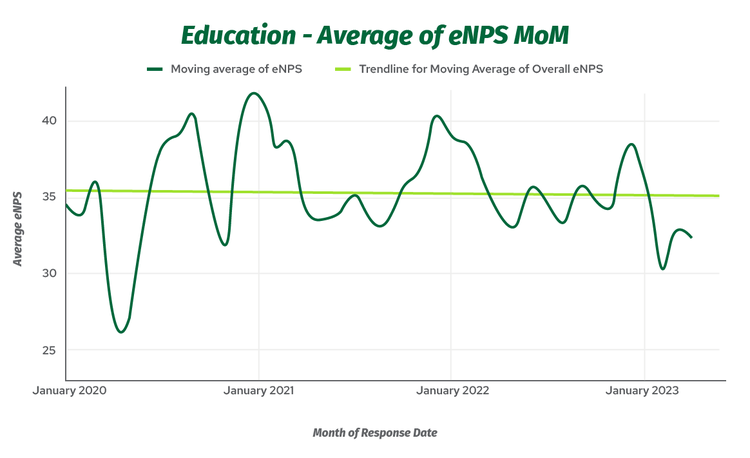
Unfortunately, unhappiness appears to be growing. From January through May 2023, the industry experienced a trendline decreasing by a rate of 97%.
School administrators may not be able to solve these issues immediately, or fully control the causes of widespread unhappiness. However, they can advocate for changes that teachers value:
Stress management: The pandemic took a major toll on educators, and lingering stressors show no signs of stopping. According to a National Education Association survey of more than 3,600 educators, 55% are considering a career change or early retirement. Black and Hispanic educators are especially likely to consider leaving the industry.
Adequate compensation: Job satisfaction is at an all-time low for educators, with many feeling overworked, underpaid, and underappreciated. A survey of 1,300 educators commissioned by EdWeek found that just 12% are "very satisfied" with their jobs. Experts say the causes are complex and layered, including poor workplace cultures, standardized testing, and burnout-inducing workloads caused by staff shortages. Contributing to generally poor morale, the majority of teachers (74%) feel unsatisfied with their compensation.
Support while managing political pressure: Outside the classroom, political debates over curricula have sparked discord between teachers and the communities they support, and less than half of teachers (46%) feel respected by the public.
8. Unhappiest Industry: Healthcare
Of the eight industries we examined, healthcare is the unhappiest. Since 2020, employee happiness has seen a steep 40% rate of decline for its trendline. Unhappiness accelerated in 2023 as the trendline dipped to a decreasing rate of 89%.
The industry's average eNPS has dropped about 4 points each year since 2020.
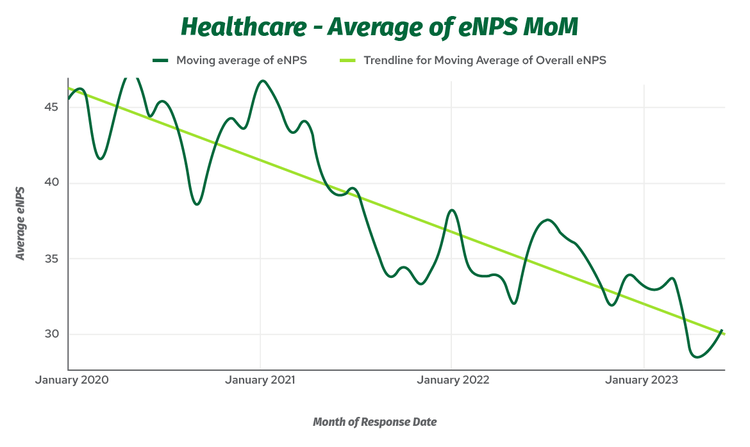
The healthcare industry urgently needs to address the causes of widespread unhappiness—especially the trauma, dissatisfaction, and burnout resulting from the pandemic.
Dire outlook: A report by Elsevier Health found that 71% of US doctors feel their roles have become worse over time. As a result, nearly half of US healthcare workers (47%) plan to leave their current positions by 2025—and among them, 39% plan to leave the healthcare profession altogether. Most clinicians (74%) predict that healthcare staff shortages will worsen with time.
Refocus on values: Healthcare workers are extremely value-driven and place a heightened emphasis on the organizational culture of their workplace. A peer-reviewed study of more than 20,000 healthcare professionals found that efficient teamwork and feeling valued are associated with lower burnout.
Think beyond practitioners: A 2023 Harvard Business Review analysis found that healthcare professionals—including clinicians, administrative workers, and maintenance staff alike—are more likely to commit to a values-driven employer who prioritizes high-quality, patient-centered care.
ABOUT BAMBOOHR
BambooHR® is the leading HR software solution that sets people free to do great work, by managing the complex work of supporting employees and succeeding as a business, while giving leaders all the data they need to make informed strategic decisions. We bring together everything from hire to retire, helping businesses create amazing workplaces. With our complete HR platform, you can easily hire and onboard top talent, manage time, payroll, and benefits, analyze employee data, and more. Our mission is to set you free to focus on what matters most: your people. To find out more, visit bamboohr.com or follow @bamboohr on social media.
METHODOLOGY
All source data is from BambooHR’s eNPS platform, gathered between January 2020 and June 2023, and includes more than 1,600 companies, tracking over 57,000 unique employees’ responses from small and medium-sized organizations within the US and internationally. Data analyzed includes more than 1.4 million self-reported eNPS scores since January 2020.
Industries included are healthcare, finance, construction, travel and hospitality, restaurant / food and beverage, education, and technology.
Volatility is calculated monthly using the difference between that month and the previous month’s average eNPS.
BambooHR Employee Satisfaction
Take your engagement strategy to the next level. With accurate, reliable employee surveys in BambooHR, you'll gain the insight you need to prevent burnout, improve morale, and stop premature turnover in its tracks.
How US Workers Feel About Their Job Prospects (2023 Data)
In the past year, the majority of U.S. workers have considered leaving their jobs. We surveyed 1,500 employees to find out why. Learn more.
How to Gain Key Employee Insights with eNPS and Employee Satisfaction Surveys
Start collecting data with employee Net Promoter Score (eNPS) and employee satisfaction surveys to gain valuable insights on how to support your employees.